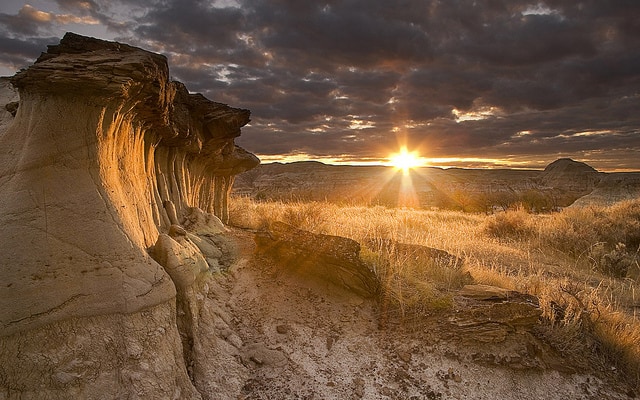Approximately 145 million years ago, Midwestern North America was a lush tropical habitat that was complete with its own vast inland sea. Humans weren't the rulers of the terrain - instead massive dinosaurs of every shape and size strolled like kings through the landscape.
Those days are long past, but today, the Canadian Badlands in Alberta have yielded some of the richest deposits of prehistoric fossils and dinosaur finds from the ancient seabed that once covered the area.
During the 19th century, some of the most important dinosaur discoveries were unearthed, including the province's namesake dinosaur - the albertosaurus. Now visitors to Alberta can take their pick from a whole slew of dinosaur-themed activities to get their fix of prehistoric times.
Dinosaur Provincial Park
 creativecommons.org/ jonebabana
creativecommons.org/ jonebabana
Located about three hours southeast of Calgary is Dinosaur Provincial Park. The park is situated in the valley of the Red Deer River, which is recognized for its striking Badlands topography. Dinosaur Provincial Park was also inducted into UNESCO's World Heritage List in 1979, but it was not the Badlands topography that merited the nomination - but the fact that 40 species of dinosaur were discovered in the bone beds of the park.
Over 500 specimens have been removed and sent to museums around the world. From microscopic fern spores to the bones of large carnivores, all manner of fossils have been discovered there, and the bone beds are still being excavated today.
Unfortunately, much of the park is restricted to the palaeontologists that converge on the area every year for a ten-week digging season. In the open areas of the park, curious visitors can hike the five self-guided trails, view outdoor exhibits, take bus tours around the area or go on private fossil safaris. There is also a lot of great camping in the area, and you never know what could still be waiting to be discovered deep beneath the ground.
Royal Tyrrell Museum of Palaeontology
 Creativecommons.org/Mike Beauregard
Creativecommons.org/Mike Beauregard
Dinosaur Provincial Park is where many of Canada's fossils are dug up, but the Royal Tyrrell Museum of Palaeontology is where many of them end up after they have been unearthed. Exploring this museum, which is located near the town of Drumheller, can take the better part of a day.
This world class facility houses the largest number of dinosaur displays on the planet. Guests to the museum can visit their resident T-Rex and learn why they refer to it as "Black Beauty", or see the "Last Sea Dragon", a 75 million year old sea reptile. There’s also the Cretaceous Garden, Mammal Hall and Ice Age Hall to explore. Aside from viewing the exhibits, visitors can go on a genuine guided archeological dig, learn about fossil casting and recreation or engage in camp-ins at the museum.
Pipestone Creek
Located just south of Grande Prairie, the Pipestone Creek area is in prime Badlands territory, but more importantly, it was the home of the 1974 discovery of a 73 million year old bone bed.
This bone bed was the mass grave of a huge number of pachyrhinosaurus. To date over 100 bones have been excavated, but no one is sure just how many pachyrhinosaurus lie in this grave, as there is still much to excavate.
In 2013, construction of the new Philip J Currie Dinosaur Museum began. The museum is named after the co-founder of the Royal Tyrrell Museum of Palaeontology and it is set up to become a Mecca for palaeontologists from around the world when it opens its doors in October.
Visitors can camp in the Pipestone Creek Campground and take the museum's Dinosaur Bone Bed Tour that runs between June and August. The administration of the bone bed also allows for volunteers to try their hand at excavating bones during certain events as well.
Jurassic Forest
 creativecommons.org/Adriel Hampton
creativecommons.org/Adriel Hampton
For those that want a more visual experience than fossils, visitors to Edmonton can head to the Jurassic Forest. This 40 acre "prehistoric preserve" is a bit like stepping into Steven Spielberg's Jurassic Park movies. Visitors can go on self-guided tours through their Discovery Trail and watch gigantic animatronic dinosaurs live and breathe.
There are over 50 life-size exhibits that recreate natural forest and wetland areas along with all the dinosaurs that would have lived there during prehistoric times. From massive herbivores like the stegosaurus and the triceratops to the king tyrannosaurus rex and its rival the spinosaurus, all the popular dinosaurs are features, as well as a few lesser known varieties.
This is a great place to visit with children. However, no matter what age visitors are, getting to see these recreations in the full-sized flesh instead of just ancient fossils is an unexpected thrill.
To give the forest an extra level of depth, there are some actual living creatures within it as well, including butterflies, birds, flying squirrels, stoats and moose. After walking the Discovery Trail, children can enjoy playing on the dino-themed playground, digging for fossils or even riding a dinosaur.
Alberta Fossil Trail
 Creativecommons.org/Alex Juorio
Creativecommons.org/Alex Juorio
For those that truly want to discover all of Alberta's fossil sites, the Alberta Fossil Trail is the trek to take. It was founded by the Royal Tyrrell Museum of Palaeontology and it showcases the dramatic landscapes and rich fossil heritage of Alberta.
The museum identified and marked nine of the richest paleontological sites in Alberta that visitors can go and explore on their journey. This is not a hiking trail, as the word "trail" often suggests. Certainly, if visitors wanted to, they could hike the trail, but it spans a massive 2,500 kilometres, so it is recommended to drive the trail instead. Stops include Dry Island Buffalo Jump Provincial Park, Horseshoe Canyon and the Devil's Coulee Dinosaur and Heritage Museum.


